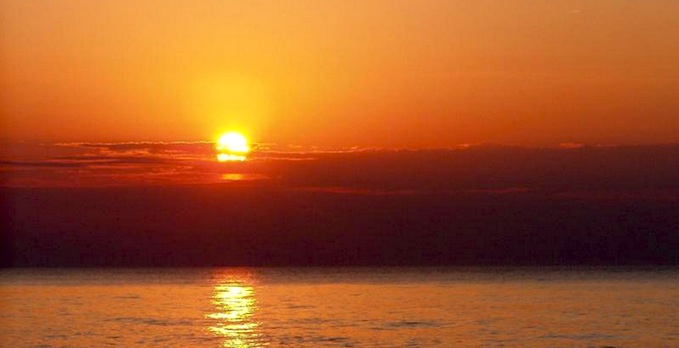
Sunset at Indiana Dunes National Lakeshore. NPS photo.
National lakeshores seem to pull at us a little harder when the weather turns warm and the waters help cool us off. Just remember, though, the Great Lakes can be as dangerous as the oceans for swimmers.
At Indiana Dunes National Lakeshore, officials want you to remember that conditions on Lake Michigan can quickly change from calm and inviting to rough and dangerous with little or no warning.
Beachgoers should remember that north winds create dangerous conditions. Steep, uneven waves have quickly overcome even the most experienced swimmers. People are easily knocked off of sandbars into deeper water. High waves are the number one cause of drowning in the park. Breaking waves and whitecaps on the lake are an indication that it is too dangerous to swim. Wave conditions of over three feet are the leading cause of drowning along the beach. Do not become a statistic, when the waves are crashing on the beach, stay on the beach.
Additionally, keep an eye on your kids, whether they're swimming or building sand castles. Each summer, many children become lost on the beach. Small children can easily succumb to the dangers of the lake, even on calm days, warn lakeshore officials. Parents should keep children within arm’s length at all times.
The use of U. S. Coast Guard approved personal floatation devices is always a good idea.
This summer, National Park Service rangers will be patrolling Lake Michigan, watching for unsafe and unlawful boating. Operating a boat in an unsafe manner or while under the influence of alcohol or drugs puts everyone on the lake in danger. Persons operating a boat under the influence are subject to arrest, fines and jail time. All boaters are responsible for being familiar with all applicable regulations and safe boating practices.
A good place to start is by visiting www.in.gov/dnr for information on state boating regulations and safety advice.
Lakeshore officials urge you to read and understand buoys and markers deployed in the lake. The National Park Service has regulations pertaining to safe boating within the Indiana Dunes National Lakeshore. The boundary of Indiana Dunes National Lakeshore extends 300 feet into Lake Michigan and includes the areas in front of the towns of Beverly Shores, Porter, Dune Acres and Ogden Dunes. Powerboats may not be launched from the beach, but they may stop and anchor outside of buoyed areas.
Muscle-powered boats (kayaks and canoes) may be launched and recovered from any beach, except the swim area at West Beach. Boats and other items left after dark are subject to removal.
While personal watercraft (jet skis, waverunners, etc.) are legal to operate on Lake Michigan, their operation within the national lakeshore is a violation of federal law. For more information about park regulations and maps of the national lakeshore, please visit the park's website.
Similar precautions should be taken at Apostle Islands National Lakeshore and Pictured Rocks National Lakeshore on Lake Superior, and Sleeping Bear Dunes National Lakeshore on Lake Michigan.

 Support Essential Coverage of Essential Places
Support Essential Coverage of Essential Places






